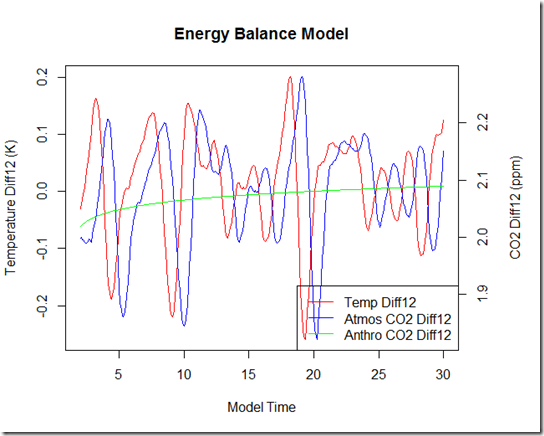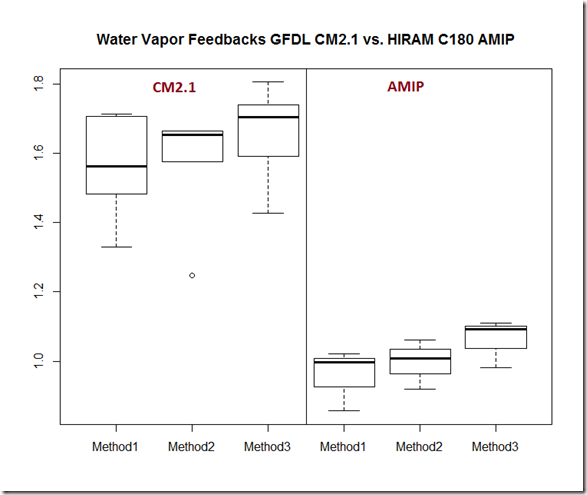This may seem a bit trivial, but since Humlum, Stordahl, and Solheim (2012)) was published in Global and Planetary Change, I thought it may be worth addressing, particularly while I still have access to these paywall articles. From the “highlights” on that link, I will note the following points:
► The overall global temperature change sequence of events appears to be from 1) the ocean surface to 2) the land surface to 3) the lower troposphere. ►Changes in global atmospheric CO2 are lagging about 11–12 months behind changes in global sea surface temperature. ► Changes in global atmospheric CO2 are lagging 9.5-10 months behind changes in global air surface temperature. ► Changes in global atmospheric CO2 are lagging about 9 months behind changes in global lower troposphere temperature. ► Changes in ocean temperatures appear to explain a substantial part of the observed changes in atmospheric CO2 since January 1980. ► CO2 released from use of fossil fuels have little influence on the observed changes in the amount of atmospheric CO2, and changes in atmospheric CO2 are not tracking changes in human emissions.
My bold. Essentially, the method in HSS12 is to compare the “DIFF12” values for each time series – that is, for each month they find the difference between the last 12 months and the 12 preceding months. In general, they find that the fluctuations in DIFF12 of temperatures lead the fluctuations in DIFF12 of atmospheric CO2, and then conclude:
In general, we find that changes in atmospheric CO2 are lagging behind changes in any of the five different temperature records considered. The typical lag is 9.5-12 months for surface temperatures and about 9 months for lower troposphere temperatures, suggesting a temperature sequence of events from the surface to the lower troposphere.
As cause always must precede effect, this observation demonstrates that modern changes in temperatures are generally not induced by changes in atmospheric CO2. Indeed, the sequence of events is seen to be the opposite: temperature changes are taking place before the corresponding CO2 changes occur.
In case one may mistake this to mean “temperature changes on a short-term scale”, they discuss later:
A main control on atmospheric CO2 appears to be the ocean surface temperature, and it remains a possibility that a significant part of the overall increase of atmospheric CO2 since at least 1958 (start of Mauna Loa observations) simply reflects the gradual warming of the oceans, as a result of the prolonged period of high solar activity since 1920 (Solanki et al. 2004).
For me, the easiest way to prove that the conclusions don’t follow from a particular method is to use a simple model where we know the actual causes and parameters, and then see if using the particular method will accurately diagnose the “cause.”
Here, I’ll dust off that old one-box energy balance model. Script is available here. Some key aspects of this demo:
- I’ve set the increase in CO2 due to anthropogenic emissions to increase at a nearly linear rate of about 2 ppm / year, with some slight curvature for realism.
- I’ve included ENSO variations for temperature changes, using the actual Nino34 index.
- I’ve set the atmospheric CO2 value to respond slightly to temperature after 11 months.
Running the “simulation” yields the following temperature response:
And here is the annual atmospheric CO2 for the run:
As you can see, that annual CO2 seems to vary little from temperature changes. But what happens when we use the DIFF12 method from HSS12?
Well, according to HSS12, this graph would imply that most of the CO2 increase over the model run must be due to surface/ocean warming (and not the other way around), since temperature diffs clearly lead those CO2 DIFF changes by 11 months! Furthermore, anthropogenic CO2 would appear to have almost no effect on total atmospheric CO2! Of course, there’s one huge problem with these conclusions: we know that they are wrong, because we set the parameters for the model. In fact, we can calculate precisely the percent of the atmospheric CO2 increase that was caused by surface warming by subtracting the “resulting” atmospheric CO2 from the anthropogenic CO2: 0.33 ppm out of 62.2 ppm, or 0.5%. In other words, 99.5% of the CO2 increase in this model run is the result of the programmed anthropogenic emissions, despite what the DIFF12 chart would appear to show.
Clearly, the HSS12 “DIFF12” method is not able to diagnose the long-term cause vs. effect. Rather, it is quite easy for a small CO2 response to temperature, particularly one which will have no long-term impact, to create results in the DIFF12 graphs that make them appear (incorrectly) to provide great explanative power. In other words, the method chosen in the paper does not support its conclusions.
So, does anybody with an academic grant for page fees want to take lead author on the reply for some easy publication credit? :)





